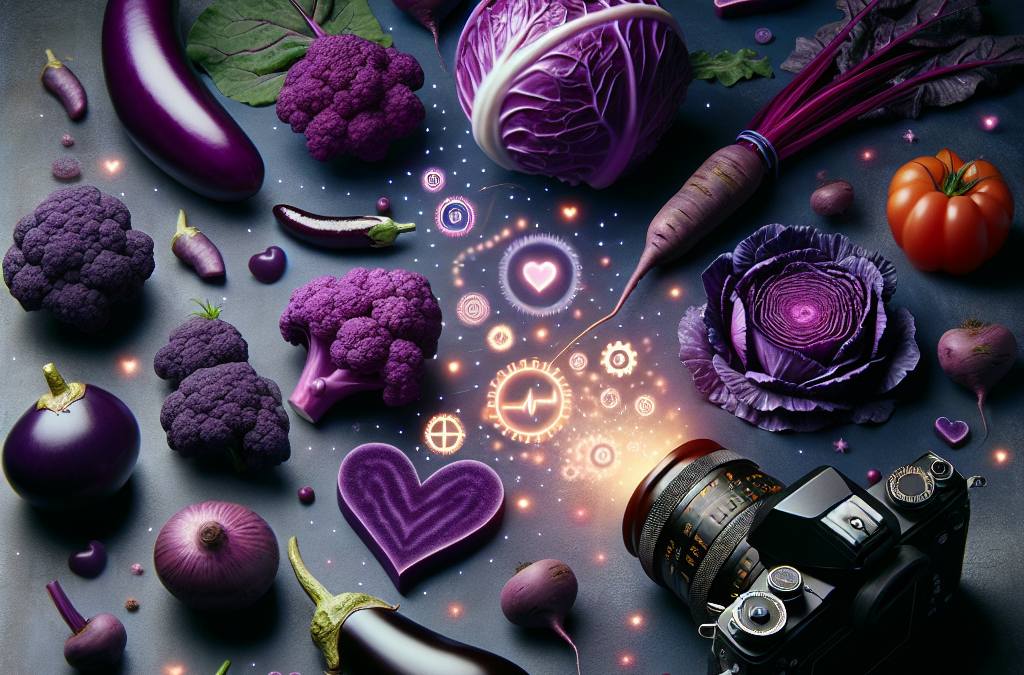1. Nutritional Powerhouses
Packed with Antioxidants
Let me tell you; when I first got into healthy eating, I was amazed to learn just how beneficial purple vegetables can be. These veggies, like eggplants, purple carrots, and purple sweet potatoes, are loaded with antioxidants, which are crucial for fighting off free radicals in our bodies. Seriously, a colorful plate not only looks appealing but also boosts your health!
Antioxidants play a major role in reducing the risk of chronic diseases. I found that adding a purple veggie here and there was an easy way to incorporate extra nutrients into my meals. For instance, every time I whip up a stir-fry, I toss in some purple cabbage or eggplant for that extra pop of color and health benefits!
What’s even cooler? The specific antioxidants in purple vegetables, like anthocyanins, have been tied to a reduced risk of heart disease. So, not only are you elevating your meal, but you’re also doing wonders for your ticker!
Fiber-Rich Choices
If there’s one thing I learned over the years, it’s that fiber is your best friend when it comes to digestion. Purple vegetables are fantastic sources of dietary fiber, which aids in keeping our gut health in check. I can’t emphasize enough how incorporating more fiber has changed the game for me!
When I first started focusing on fiber intake, I noticed an increase in energy levels and even better mood swings. Foods high in fiber help prevent constipation; something we all want to avoid, right? Just think of purple veggies as your gut’s cheerleaders, encouraging everything to process smoothly!
Incorporating more fiber also helps with weight management. When I feel full longer after eating, I find it’s easier to resist those pesky snacks that can derail my healthy habits. So, whether it’s a smoothie with some spinach or a roasted dish with beets, I’m always looking to bump up my fiber intake!
Vitamins Galore
Let’s take a minute to soak in the sheer variety of vitamins purple veggies offer. From Vitamin C to Vitamin K, these vibrant choices provide essential nutrients we often overlook in our diets. The first time I casually sautéed some purple Brussels sprouts, I was surprised at not just the taste but also how packed with vitamins they were!
Vitamin C, found in abundance in purple kale and radishes, is vital for a robust immune system and skin health. I’ve personally noticed that on days I load up on these veggies, I feel a little more invincible—like I can take on anything!
The best part? Many purple vegetables are also high in Vitamin K, which is critical for bone health. This fact alone has motivated me to keep a steady rotation of these colorful gems in my weekly meal prep, ensuring I’m not just eating for taste but also for my health!
2. Deliciously Versatile
Creative Culinary Uses
This is where the fun starts! I’ve had such a blast experimenting with purple vegetables in the kitchen. Whether I’m adding purple sweet potatoes to my fries or a splash of purple cabbage to tacos, the flavor and visual appeal are always a win. Have you ever roasted purple carrots? They caramelize beautifully and taste just divine!
Salads become a feast for the eyes when you throw in some shredded purple cabbage or beet slices. Trust me, your guests will be raving about the presentation. It’s not just about health; it’s about creating a colorful work of art on the plate!
If you love smoothies, consider tossing in some purple spinach or even some acai berries for that antioxidant boost while keeping the flavors delicious. The variety of tastes and textures you can create is simply endless, and that keeps meals exciting!
Perfect for Any Season
What I love about purple vegetables is that they’re available year-round, so there’s no excuse not to get your fill! Whether it’s grilling eggplant in the summer or roasting root veggies in the fall, these gems are ready for any dish. I really enjoy how I can adapt my meals no matter the season.
In winter, a hearty purple vegetable stew warms you up while providing all those fantastic nutrients. During the summer, I love including them in refreshing salads or dipping them in hummus. Whatever the situation, purple veggies fit right in!
This seasonal versatility not only keeps your palate happy, but it also encourages you to eat a variety of phosphates, making your meals more dynamic and flavorful. Who wouldn’t want that in their life?
Kid-Friendly Options
Getting kids to eat vegetables can be quite a challenge, but I’ve found a sneaky trick: purple veggies! Adding a splash of purple to their plates tends to spark curiosity. I remember one time making a vibrant smoothie bowl topped with purple berries and granola, and my kids were all in!
Purple veggies can be super fun to incorporate into meals. Making a pizza topped with purple cabbage or creating colorful veggie sticks for dipping can turn a mundane meal into a playful dining experience. Even my pickiest eaters are willing to give it a shot!
Plus, when kids see bright, colorful food, they usually want to taste it. With a little creativity, it’s possible to introduce some healthy habits early on, making it more likely that they’ll embrace a variety of vegetables as they grow!
3. Rich in Flavor
Distinctive Taste Profiles
Aside from being eye-catching, the flavor of purple vegetables is something to write home about. Each type has its unique taste—eggplants are meaty and rich, while purple potatoes have a slightly nutty flavor. Honestly, discovering these different profiles has been an exciting journey for my taste buds!
I love roasting or grilling my purple veggies, as it really brings out the sweetness. The other night, I tossed some cubed purple sweet potatoes into the oven, and WOW, they caramelized into a sweet, crispy delight that had everyone at the table asking for more!
Trying out new cooking methods opens up a whole new world of flavors. If you haven’t yet, I highly recommend simmering purple cabbage in a little apple cider vinegar—it turns what could be a dull side into a tangy sensation that complements almost any main dish!
Pairings That Shine
When it comes to food, I’m all about pairing. Purple vegetables complement so many other foods effortlessly! For instance, pairing roasted purple carrots with a feta cheese sprinkle creates a delicious sweetness and creaminess that’s hard to resist.
Even simple dips can elevate your veggie game. Pair purple bell peppers with a spicy hummus or tzatziki sauce, and you’ve got an appetizer that disappears in no time. These bold flavors can take your gatherings up a notch!
Incorporating herbs and spices can also enhance their natural tastes. I love tossing some fresh thyme or rosemary on roasted eggplant—it’s like a hug in flavor form! Experimenting with different combinations has allowed me to discover tons of yummy pairings.
Freshness Matters
Freshness plays a huge role in flavor, and eating seasonal purple veggies means you’re getting them at their peak. Visiting local farmers’ markets has been a game changer for me; I’ve found the freshest purple produce that bursts with taste and freshness!
Get an Amazing Discount on the Best Certified Organic Whole Food Supplement!
Plus, I’ve learned that ordering local produce can be a way to not only support small businesses but also ensure I’m cooking with the best ingredients available. The difference in flavor is huge—everything is brighter and more delicious!
A simple, fresh salad with vibrant ingredients can do wonders; it’s all about honoring those natural flavors and textures. Take some time to learn about in-season options! It can elevate your meals like you wouldn’t believe!
4. Visual Appeal
A Feast for the Eyes
Let’s be real; who doesn’t love a beautifully plated dish? Purple vegetables naturally stand out on your plate, offering a delightful contrast to greens and neutrals. Back when I started promoting a healthy lifestyle, I realized this was a simple yet effective way to entice people in.
I always enjoy a colorful array on my dining table. Whether it’s a vibrant multi-colored salad or a stir-fry with purple cabbage, it draws everyone in. When people see those rich hues, it makes them inclined to taste what’s being offered, and that’s half the battle with nutrition!
Plus, the vibrant colors of purple veggies can enhance any dish’s attractiveness. You can make food more inviting, especially for those who might be hesitant about trying new things. Bright colors tend to stimulate the appetite and make meals more enjoyable!
Artistic Presentation
I love getting creative with the presentation of food. Using purple vegetables allows me to play with different shapes and styles when plating. I’ll sometimes spiralize purple sweet potatoes or use a mandoline slicer for beautiful ribbons of purple cabbage. It adds an artistic flair to my meals!
Creating visually appealing dishes can make your meals feel special, elevating even the simplest recipe. I’ve hosted several dinner parties where guests complimented the styling of food—thanks to my trusty purple veggies!
In my experience, this aesthetic approach encourages my guests to dig in and enjoy their food more, which is ultimately what we want in every meal—happiness and satisfaction!
Color Psychology
Did you know that colors can affect our moods? Incorporating purple vegetables into meals can actually evoke feelings of calmness and positivity. I read about color psychology while exploring nutrition, and I was amazed at how something as simple as color can influence how we feel about food!
When I serve colorful dishes, I notice that people seem more relaxed and engaged during meals. It can be especially important during casual gatherings or family dinners; a colorful table can lighten the mood and encourage conversation!
Understanding the emotional aspect of food has changed how I plan my meals. I genuinely believe that introducing colorful, happy food creates an inviting, warm environment for anyone at the table.
5. Sustainable Choices
Locally Sourced Benefits
Going purple can also mean going green for the environment. I make a conscious effort to choose locally sourced purple vegetables when I can. Not only does it support local agriculture, but it’s also better for the planet since it reduces greenhouse gas emissions from transport.
Buying local also tends to ensure you’re getting fresher produce, which in terms of flavor and nutrients, makes a huge difference. Developing a relationship with local farmers has been a rewarding experience for me—it usually means I get to try out some unique varieties too!
Plus, many farms practice sustainable farming techniques which are beneficial for the ecosystem. By selecting purple veggies from local farms, I can feel good about my choices—both for my health and our planet.
Seasonal Eating
Focusing on seasonal produce is a win-win in my book. Not only do you consume more delicious purple veggies when they’re at their prime, but you’re also contributing to more sustainable agriculture. This way of eating has inspired me to be more adaptable and explore various meals depending on the season!
Seasonal eating also encourages variety in your diet. As each season brings different purple offerings, I’ve discovered new recipes and flavors I may have otherwise missed. This makes meal prep much more interesting and enjoyable!
I also find this method creates more awareness of food sources. Knowing what enriches my local environment makes me feel a little more connected to my meals, which totally enhances the overall experience of cooking and eating!
Reducing Waste
Lastly, I have started to look at how I can minimize food waste in my kitchen, particularly with these gorgeous purple veggies. Learning to use every part of the vegetable—from the leaves of purple beet greens to stems of purple broccoli—has been both gratifying and delicious!
I’ve taken to composting scraps, which is a great way to give back to the earth rather than tossing leftovers aside. Trust me, I’ve had my fair share of fails, but trying to utilize what I can feels like a worthy challenge that pays off!
Thinking creatively about vegetable scraps has opened me up to a plethora of new recipes. It’s amazing how resourceful you can become when you’re passionate about eliminating waste. Plus, wearing that sustainability badge feels good!
FAQs About Purple Vegetables
1. What are some common purple vegetables I should try?
There are many delicious options, including eggplants, purple sweet potatoes, purple carrots, purple cabbage, and beets! Each one carries unique flavors and health benefits.
2. How can I incorporate more purple vegetables into my diet?
Start by adding them to your favorite dishes! You can include purple veggies in salads, smoothies, stir-fries, or even as roasted snacks. The key is to have fun with it!
3. Are purple vegetables healthier than other colors?
While all vegetables are nutritious, purple vegetables are particularly rich in antioxidants, vitamins, and minerals. They can provide unique health benefits that you might not get from other colored veggies.
4. Do purple vegetables actually taste different?
Yes! Each vegetable has its own distinctive flavor profile. For instance, purple sweet potatoes are sweet and nutty, while purple eggplants have a meaty texture.
5. How do I know if purple vegetables are fresh?
Look for vibrant colors and firm textures; they should feel heavy for their size, and their leaves should be crisp. It’s best to buy from local sources or farmers’ markets for peak freshness!




